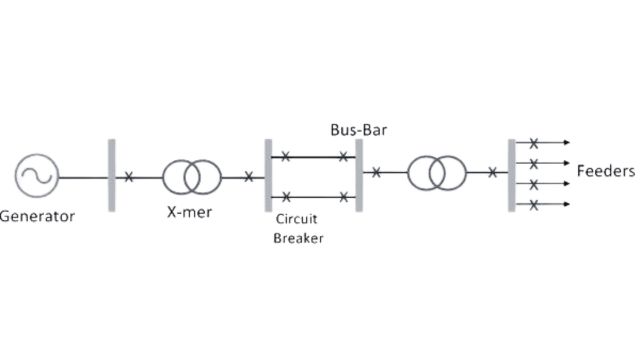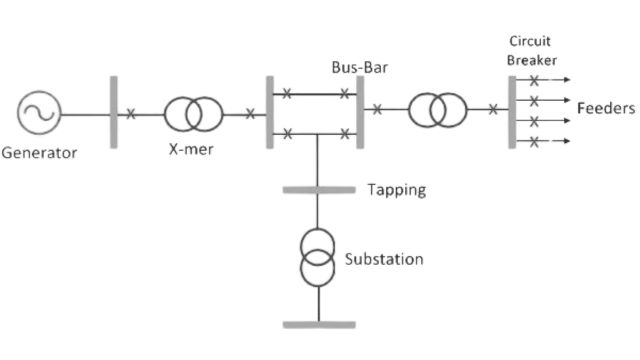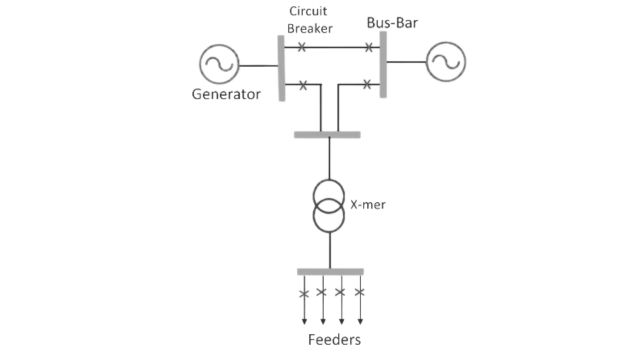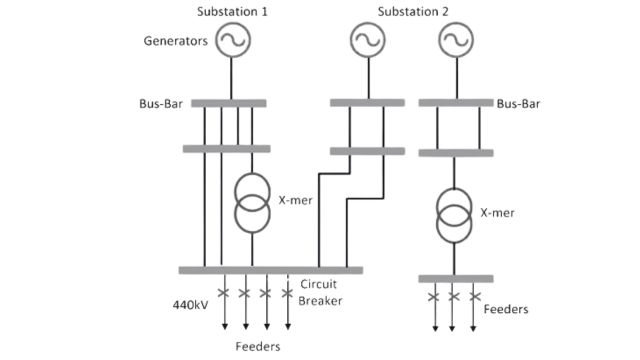
Table of Contents
Introduction
A substation is a crucial part of an electrical supply system that helps transfer high-voltage electricity from power plants to local areas where it is needed. The voltage might change several times between the power plants and the local areas through different substations.
Types of layouts for Substations
The different types of layouts for substations are explained below in detail.
- Typical Radial Substation
- Tapped-Substation
- LILo (Line In Line Out) Substation
- Interconnected Substation
1. Typical Radial Substation
In a radial substation, only one power source supplies electricity to the load. This system is unreliable because the entire area will lose power if the power source fails or a line develops a fault. Radial substations are typically used in distribution systems in rural areas where the electricity demand is not very high.

2. Tapped-Substation
This power supply system is unreliable and insecure because if the power source or line fails, the entire area will lose electricity.

3. LILo (Line In Line Out) Substation
In this substation, a long power line comes in and goes out from the new substation. This setup costs more because it needs extra infrastructure but it is more reliable.

4. Interconnected Substation
This is the most preferred power supply system because it is safe, secure and reliable. If the main power source or line fails, the power supply is not affected because there are many backup options available.

Advantages of Different Substation Layouts
1 Single Busbar Layout
Simplicity: Easy to design, operate and maintain.
Cost-effective: Lower installation and maintenance costs due to its simple structure.
2. Double Busbar Layout
Flexibility: Allows for maintenance on one busbar without interrupting the power supply.
Reliability: Provides a backup busbar, enhancing system reliability in case one fails.
3. Ring Bus Layout
High Reliability: If a fault occurs in one section, the power can still be rerouted through the remaining sections.
Ease of Maintenance: Sections can be maintained without affecting the entire system.
4. Mesh (or Grid) Substation
Very High Reliability: Multiple interconnected paths ensure a continuous power supply.
Scalability: Can handle high load demands and is suitable for expanding large networks.
5. Sectionalized Busbar
Fault Isolation: Only the faulty section is isolated, while the rest of the system remains operational.
Maintenance Efficiency: Easier to perform maintenance without causing a total shutdown.
Disadvantages of Different Substation Layouts
1. Single Busbar Layout
Low Reliability: A fault in the busbar can disrupt the entire power supply.
Maintenance Issues: Requires a complete shutdown for maintenance or upgrades.
2. Double Busbar Layout
Higher Cost: More expensive to install and maintain due to the additional infrastructure.
Complexity: More complex to operate and manage compared to a single busbar layout.
3. Ring Bus Layout
Moderate Cost: More expensive than single busbar layouts due to additional busbars and switchgear.
Fault Management: While reliable, faults can still affect multiple connections before being isolated.
4. Mesh (or Grid) Substation
Very High Cost: Most expensive to install and maintain because of its complex structure.
Complex Operation: Requires advanced management and control systems to operate efficiently.
5. Sectionalized Busbar
Moderate Cost: More expensive than a single busbar due to additional circuit breakers and equipment.
Operational Complexity: More complex to operate and manage compared to simpler layouts.
Applications of Different Substation Layouts
1. Single Busbar Layout
Small Distribution Systems: Ideal for small towns or rural areas with lower power demands.
Industrial Plants: Suitable for small industrial plants with a single power source.
2. Double Busbar Layout
Urban Areas: Used in cities where reliability and flexibility are critical.
Large Industrial Facilities: Suitable for large factories requiring continuous power and frequent maintenance.
3. Ring Bus Layout
High-Reliability Areas: Applied in areas where continuous power supply is essential, such as hospitals and data centers.
Suburban Networks: Suitable for suburban regions needing a balance of reliability and cost.
4. Mesh (or Grid) Substation
Metropolitan Areas: Best for large cities with high power demands and the need for very high reliability.
Critical Infrastructure: Used in national grid systems and critical infrastructure where any downtime is unacceptable.
5. Sectionalized Busbar
Medium-Sized Cities: Ideal for cities requiring reliable power but with moderate complexity and cost considerations.
Mixed-Use Developments: Suitable for areas combining residential, commercial, and industrial loads that benefit from fault isolation and maintenance flexibility.
Frequently Asked Questions (FAQs)
What is the substation layout?
A substation layout is the physical arrangement of electrical equipment within a substation, designed to ensure the safe, efficient, and reliable operation of power distribution.
What is the planning of substations?
Planning substations involves selecting locations, designing layouts, choosing equipment, and ensuring safety and reliability to meet present and future electrical power distribution requirements efficiently.
What are the steps in a substation design?
The steps in substation design include site selection, determining electrical requirements, designing the layout, selecting equipment, planning for safety and protection, ensuring regulatory compliance, and preparing detailed engineering drawings and specifications.












Leave a Reply